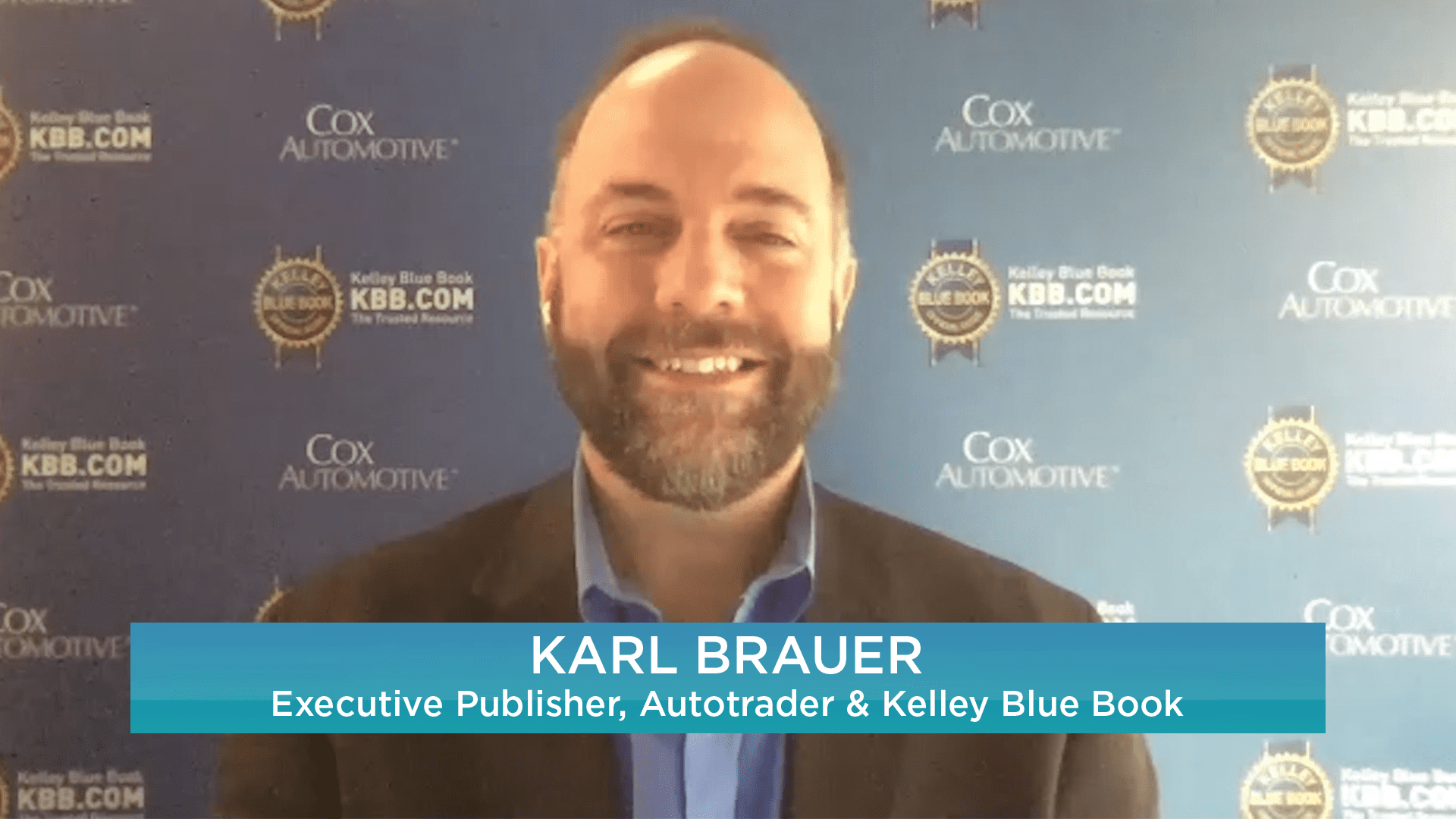The automotive retail industry has come a long way since 2010, and as we wrap up 2019, we take a look back on the decade’s defining factors and look ahead to its emerging trends. Here to share his insight on the last 10 years, is Karl Brauer, executive publisher for AutoTrader and Kelley Blue Book.
Jim Fitzpatrick: Hi everyone, Jim Fitzpatrick. Welcome back to CBT News. We are happy to have with us today, Mr. Karl Brauer. I know that you know this name and this face. He’s been a visitor here at CBT News many times. Karl, welcome back to the show.

Karl Brauer: Hey, always fun to be on with you, Jim. Lots going on as always.
Jim Fitzpatrick: Yeah, that’s what we want to talk to you about. So as we enter the next decade here, what were some of the defining factors in the last decade, I should say. We’re going to go all the way back here, but in the auto industry.
Karl Brauer: I think there’s no denying the sea change in technology and the role it’s played in the automotive world. Right? And it’s not like we didn’t see this coming technologies played an increasing role in automotive for the past hundred-plus years since automotive has been around.
Jim Fitzpatrick: Sure.
Karl Brauer: But I really feel like, and I think most consumers would agree, that there’s been a drastic shift in the level of interplay between the average consumer and their vehicle and the technology that really plays a role in both areas, both in how the car drives but also in how the consumer interacts with the car. Big change from the last 10 years.
Jim Fitzpatrick: That’s for sure. And you know, with all the technology that’s in vehicles today, you wonder, and I know this is probably asked every 10 years, but how can they top this? What are they going to do? What’s going to be next? And I guess the self-driving cars or autonomous vehicles is what’s next. I mean the vehicles are so loaded up with incredible technology today that your mind just explodes when you say, “How are they going to top this show?”
Karl Brauer: Right. And you know, I think that’s kind of the end game, right, that everyone’s waiting for is autonomous cars that can drive them wherever they want to go. And they can do anything from sleep to watch a movie, to have a conference call and a business call. Never even have to concern themselves with the whole rudimentary driving thing. Oh, how passe, right? That’s where we’re headed.
Karl Brauer: But what’s going to be interesting is the interim and what we’re going to see. We’ve already seen advanced driver assist systems that are making it so cars will automatically stop if they think there’s going to be an impact, or they’ll help you stay in your lane, and they’ve got smart cruise control that makes it easy to drive in stop-and-go traffic. Now the cars will completely come to a stop and then start rolling again.
Karl Brauer: And we’re going to see cool things well before autonomous vehicle. We’re going to see things like the connected car that we’ve already got getting more and more connected. For instance, health monitoring devices maybe in the steering wheel that measures your pulse or in a seatbelt that measures your heart rate. And if there’s a problem, the car could call an ambulance to your location even before you know you need it. It could start deciding this person’s about to have a stroke or a heart attack-
Jim Fitzpatrick: Unbelievable.
Karl Brauer: … and get some help before you ever expect it. I mean, how crazy is that? And we’ve got cameras now that are all around the car that make it easier to park and some, some of these cameras now can the car when you’re away from it so that you can actually see the car and see what’s going on when you’re not near the car, a little peace of mind, make sure no one’s messing with your car, that kind of thing. There’s going to be a long list of those kinds of things that we don’t really have yet, but they’re right around the corner and they’ll come well before an autonomous and they’ll keep making the car feel more and more technologically advanced even before it drives itself.
Jim Fitzpatrick: And all of these things that you just mentioned, keep those consumers coming back to the showroom for more and more, right? I mean, if somebody doesn’t already have a backup camera, they want that. If somebody doesn’t have the self-driving capability, when they’re on a long drive, they can hit the button and the car will pretty much stay in its own lane. They want to come back for that. Whatever the latest technology is, even if it’s a perfectly sound car that doesn’t need to be traded out, they want that technology, don’t they?
Karl Brauer: That’s really the key, Jim. I mean, and that’s what we’ve already seen for the last 10 years, increasingly in the last five years, which is … I always like to say it’s how many bullet points can you put in that ad about all the crazy things your car does and every, every manufacturer’s battling for bullet points. Now, over the air updates were a really big thing that Tesla introduced. Now all the other car companies want to be able to claim that they do that. There’s just a lot of things that have happened in the last five years and it hasn’t even become ubiquitous for all these great things that are on the cusp and there’s just going to keep being more and more. So yeah, it will be very vibrant, competitive technological landscape for the next 10 years. Well, before autonomous shows up.
Jim Fitzpatrick: It really begs the question, will we be looking for an entirely new skillset for salespeople that come into showrooms today to work for us?
Karl Brauer: I think technological capabilities and understanding to have the ability to describe all these tech prove very quickly and easily to a potential buyer how it makes your life easier, how it makes you feel more safe, more secure, saves you time. Those skills will be valued by dealers and salespeople because they’ll see it make a difference in the amount of vehicles that people buy and the features they want on the vehicles.
Jim Fitzpatrick: So let’s change gears a little bit here and talk about how you think we’ll end up 2019 and what we can look for in maybe first quarter. What do you think the magic SAR number will be?
Karl Brauer: I think when we have our final numbers for 2019, we’re still going to come in stronger than I think a lot of people expected. I think everyone was hoping we’d hit at least 16 and a half, and then I think some people were thinking we might get 17. I think we’ve known for a while it’s going to be somewhere in that range. And I think we’re going to hit 16.77. Do you want to try to get as specific as possible? I think they’re going to be about 16.77. I don’t think we’re going to quite hit 16.8 But we might. So I think that’s my number/
Jim Fitzpatrick: And fleet as a big to do with that. I mean that’s a big number this year, right?
Karl Brauer: It is. Fleets always a big number, and of course there’s been an increasing level of incentives in the last year or two that helps the retail side. So between two levers, there’s been a certain amount of leaning on both of them to try to increase sales. And I kept wondering if those two levers would be pulled hard enough by enough companies to get us to 17 once again. I don’t think we’re going to quite get to 17 but I think we’re going to be closer than a lot of people expected at the start of the year.
Jim Fitzpatrick: It’s still another incredible year in retail automotive, that’s for sure.
Karl Brauer: Still in the top … What is that? Probably going to be top five, top six total years of retail sales, maybe top seven and all, but it’s certainly the top 10 it’ll be another top 10 in the history of automobiles for annual car sales.
Jim Fitzpatrick: Talk to us about electric vehicles. What do you think we’re going to see in 2020? Are they making any inroads? I mean, I know it’s probably still less than two percent of the overall market each year for the last couple of years, but are they picking up any momentum?
Karl Brauer: They are, Jim, and what’s going to really be the big change again that we’re going to see, the sea change when it comes to just EVs, is going to be awareness. Because every time a new EV comes out, there’s a launch cycle, there’s a promotional effort, there’s an awareness effort by the manufacturers. And if you have one or two hit a year early, you get a little bit more knowledge about EVs and the mainstream consumer. We’re going to have 12 hit in the next two years.
Jim Fitzpatrick: Wow.
Karl Brauer: So this will be the most kind of dense time-wise and activity-wise, we’ll see the most activity that we’ve seen in EVs ever in the next two years and that by nature of brand new EVs coming out every couple of months is going to raise awareness and raise consideration just by the fact that everyone’s going to have that much more knowledge and know that they’re out there and they keep coming.
Karl Brauer: And I think that’s going to combine with some functional changes too, that most of these new EVs will have 250 to 300 plus mile range. They’ll be increased infrastructure, Electrify America, subsidiary of the Volkswagen group, it’s going to keep pushing the infrastructure message that they’re building out. And these are all the things that are going to help allay the fears. People don’t want to buy EVs because they’re worried about the cost and they’re worried about range anxiety. I think you’re going to see the cost slowly coming down and the infrastructure slowly coming up. And I think eventually it’s going to equate, it’ll be the same options on the EV side that it is in internal combustion in terms of range and frequency of fueling stations, in this case EV stations, and costs will keep dropping and you’ll eventually have an equivalency and then it’ll be easy to jump from one to the other.
Jim Fitzpatrick: Yep. I’m in Atlanta as you know, and there’s not a public parking lot I don’t think that you can go into, whether it be a shopping mall or a strip center or a park or what have you, wherever it is, there you’ve got your charging stations. And I think things like that make it so that you’re that much more aware of EVs being out there in the marketplace.
Karl Brauer: Electrify America just did an announcement about their banks. I think it was … Gosh, I’m going to forget it now, was it Chase? One of the big bank branches, I think they said they’re going to put 40 charging stations, 40 actual charging stations, with 140 total actual plugs, meaning there’ll be more than one plug per each of those charging areas across these banks. So another area, like you say, Jim, where you’ll go and you may or may not have an electric vehicle, but you’ll go to the bank, then you’ll see another option to charge and that just will keep happening like you said. And that’ll help inspire people to think, “Wow, I have a lot of options to charge. Maybe I’ll look into an EV now.”
Jim Fitzpatrick: That’s right. My son-in-law has a Tesla and I often ask him, we’ll talk about vehicles or whatever, and he’s like, “Dude, I haven’t gone to a gas station in I don’t know how long,” he said. And quite honestly he said, it’s so easy. It’s incredible. You just plug it up when you get home or for that matter he’s got a charging station at his office, so all day at charges. He said a lot of times I don’t even plug up in the garage.
Karl Brauer: Yeah. And that’s the thing is you start to get spoiled, Jim. You don’t have to go to a gas station. You take the 30 seconds it takes to plug in your car when you arrive at work or arrive at home and the 30 seconds it takes to unplug it. I mean, everyone talks about the charge time, which is longer than refueling, but the plugin time is much shorter than refueling. And if you’re plugging in at work and plugging it at home,-
Jim Fitzpatrick: It doesn’t matter.
Karl Brauer: … recharge time is transparent. You don’t know. You’re inside doing other things while the car’s charging.
Jim Fitzpatrick: Yeah, versus-
Karl Brauer: You start realizing you got to make a separate trip and get out your credit card and do all these things and take 20 minutes between driving and filling up, and charging at home starts to seem like a real luxury.
Jim Fitzpatrick: There’s no question. And if it’s crappy outside and rainy or cold or snowing or whatever, you don’t even want to get to your car, and here, if I had an electric vehicle, I could just drive right into my nice warm garage and hook up and I’m done. Right?
Karl Brauer: And don’t forget, the next big thing we’re going to see is wireless charging, Jim. So now you’re going to take away the 30 second plug-in time. You’re going to drive into your garage, get out and walk inside and your car is charged.
Jim Fitzpatrick: So what do you think we’ll see for the first quarter of 2020 in the way of sales?
Karl Brauer: I think it’s going to be very interesting, but I think we’re seeing a lot of moves on kind of the economic side. We’ve got crazy numbers just right now in terms of a lot of the stock indexes, and there’s some real confidence that seems building again, because some of these trade deals seem to be coming together. I think the trade deals are going to be the bedrock of so much activity, whether it’s cars, whether it’s housing, whether it’s all the economic numbers, hopefully continued low unemployment, and I think those are going to go in a good way in the next 60 days. And if that’s what happens, then I think the first quarter could end up being as strong or stronger than we saw last year or the year before. We could end up with a real good start to the year. If these trade talks go as well as they seem like they probably will go. But yeah, I think we could see some powerful SAR starting as early as January and certainly once you get into February and March, if they resolve all these trade talks.
Jim Fitzpatrick: And this being an election year that’s probably in our favor in a big way, especially with this president that wants to make some tracks out there.
Karl Brauer: Yeah. If he gets the trade deals done and all the other talk of who’s going to be actually in the office and all, if we start to get that resolved, it doesn’t even really matter who your favorite candidate is, usually economic factors like stability, and if we can get into a sense of stability both on our trade issues and on our leadership issues, then actually 2020 could be a pretty up year for car sales.
Jim Fitzpatrick: Well, Karl Brauer, executive publisher for Autotrader and Kelley Blue Book, I want to thank you so much. It is always a pleasure having you in each month to talk about this and what we’re doing in the automotive space, and congratulations on another great year.
Karl Brauer: Yeah. No, congrats to all of us. It’s fun always talking to the industry with you, Jim, and it’s never a dull moment, and I think 2020 will give us plenty to discuss as we head into a whole new year. Absolutely.
Jim Fitzpatrick: We’ll do one more of these and then the next time I see you, you’ll be at NADA, right?
Karl Brauer: Absolutely. Yeah. We’ll be out there looking at all the dealer activity and there’s going to be a lot this year.
Jim Fitzpatrick: Oh yeah, I think so. Especially … and it’s at Vegas, so it’s a win-win.
Karl Brauer: Never a dull moment now just in that city.
Jim Fitzpatrick: That’s right. That’s right. All right. Thanks so much, Karl. Appreciate it.
Karl Brauer: Great being on with you, Jim. Have a good one. Happy New Year.
Jim Fitzpatrick: You, too.
CBT Automotive Network. The number one most-watched network in retail automotive. This has been a JBF Business Media production.









